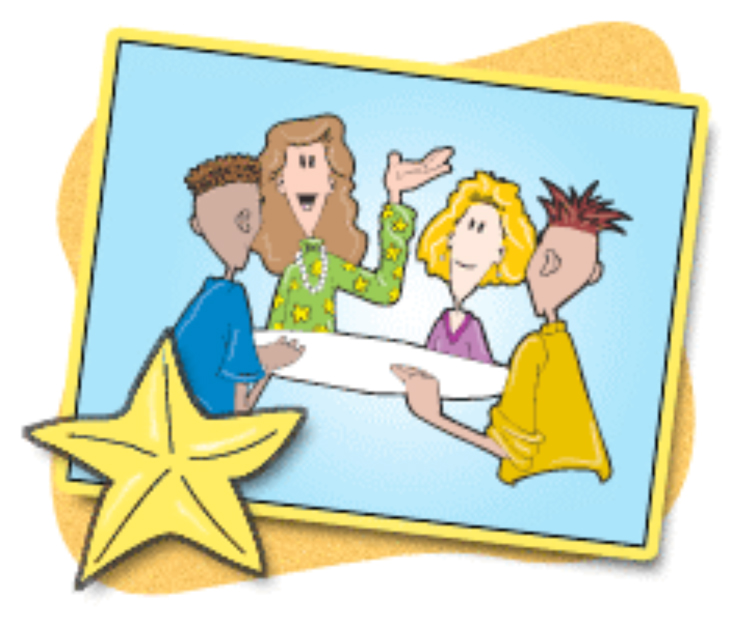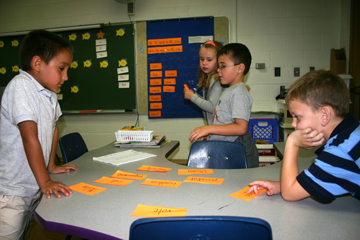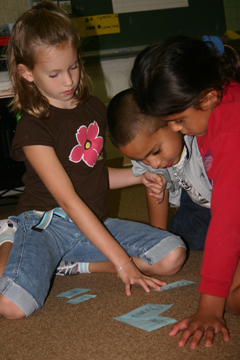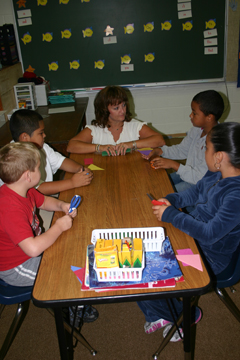College of Education & Human Services
Lesson 3: Supporting ELL Students While Extending
Their Skills in Language and Content
Understanding the WIDA English Language Proficiency Standards: A Resource Guide
“Support is an instructional strategy or tool used to assist students in accessing content necessary for classroom understanding or communication.”
“Support may include teaching techniques, such as modeling, feedback or questioning."
“Other types of support involve students using visuals or graphics, interacting with others or using their senses to help construct meaning of oral or written language (TESOL, 2006).”
“We believe that support is important for all learners to gain access to meaning through multiple modalities, but it is absolutely essential for ELLs.”
“For this reason, we incorporate support within the MPIs through English language proficiency level 4. We feel that support for ELLs needs to be present in both instruction and assessment on both a formative and summative basis.”
“Supports within the MPIs may be sensory, graphic or interactive.”
ELLs come to school with diverse languages and cultures. These resources should be recognized, preserved and strengthened even if they may not coincide with the language of instruction.
Sensory Supports
Some sensory supports are applicable across all ELP standards. Others are specific to the language of a content area. The use of these sensory supports in activities, tasks and projects helps promote the development of students' academic language proficiency.
Graphic Supports
The most commonly used graphic support associated with social, instructional and academic language is the graphic organizer. Graphic organizers, such as semantic maps, venn diagrams or T charts, are useful tools for ELLs.
These graphic supports allow students to demonstrate their understanding of ideas and concepts without having to depend on or produce complex and sustained discourse
It cannot be assumed, however, that ELLs understand the concept behind and automatically know how to use particular graphic organizers. Therefore, teachers must model examples of their use and give students time to practice with each one.
Graphic organizers may be used with each language proficiency standard. Teachers’ knowledge of their students and the curriculum is important in translating various organizers into instructional and assessment activities.
Interactive Supports
All students benefit from opportunities to discuss and confirm prior knowledge with each other in pairs or groups or by using interactive multimedia such as the Internet. These interactive supports are especially useful for ELLs. Their participation in interactive activities and tasks can promote comprehension and expose them to a variety of communication styles.
We also know that instructional strategies that incorporate interactive supports facilitate the exchange of cultural values, norms and behaviors and challenge students at every level of English language proficiency to meet expectations in situations that they find meaningful.
Although not formally recognized within the frameworks, the Consortium acknowledges the students’ historical backgrounds and prior educational experiences as springboards for their English language development. We deem it important to honor the cultural perspectives of our ELLs and their contributions to our multicultural society within curriculum, instruction and assessment...
Where do the following supports belong?
List each description under the correct column. Use the words listed below to complete the table
Click here to download a blank PDF of the chart below.
Click here to download a PDF of this rubric.
| Sensory Supports | Graphic Supports | Interactive Supports |
|
|
|
|
|
|
|
Supports in the Classroom Resources
The following article has been included with permission.This article can be found at:http://www.kaganonline.com/free_articles/dr_spencer_kagan/ASK38.php

Kagan Structures Simply Put
Dr. Spencer Kagan
Recently I responded to interview questions for a newspaper article. The interviewer threw me some softball questions designed to make the Kagan approach to instruction understandable to the average reader without technical expertise in education. When I finished, I realized the answers might be of use to anyone who wishes to obtain, or provide for others, a simple introduction to the Kagan approach.
What are Kagan Structures?
Structures are simple, step-by-step instructional strategies. Most Kagan Structures are designed to increase student engagement and cooperation. For example, a simple Kagan Structure is a RallyRobin. Rather than calling on one student at a time, the teacher has all students interacting at once by saying, “Turn to your partner and do a RallyRobin.” During a RallyRobin, students repeatedly take turns, giving one answer each turn to create an oral list. Each student in the class gives several answers. For longer responses, the teacher might use a different structure, a Timed Pair Share. In a Timed Pair Share, each student in turn shares for a predetermined time, perhaps only a minute each.
 The miracle of structures is that in the same amount of time that the teacher could call on and respond to two or three students in the class, each giving one answer, the teacher can have every student give several answers. In the traditional, call-on-one-at-a-time approach to instruction, it would take about an hour to have each student speak for a minute because the teacher asks the question, the student responds, and then the teacher responds to the answer, giving either a correction or praise. Further, because it tends to be the same students responding all the time, many students seldom participate, or even not at all. In the traditional approach, we end up calling most on those who least need the practice, and least on those who most need the practice.
The miracle of structures is that in the same amount of time that the teacher could call on and respond to two or three students in the class, each giving one answer, the teacher can have every student give several answers. In the traditional, call-on-one-at-a-time approach to instruction, it would take about an hour to have each student speak for a minute because the teacher asks the question, the student responds, and then the teacher responds to the answer, giving either a correction or praise. Further, because it tends to be the same students responding all the time, many students seldom participate, or even not at all. In the traditional approach, we end up calling most on those who least need the practice, and least on those who most need the practice.
In contrast, with the structures, because all the students are responding at once, it takes only two minutes to give each student a minute of active engagement time, and it is not just the high achievers responding — everyone responds. Engagement goes up, as does joy in learning and achievement scores. I have been working on the development of structures since 1968. Over the years, we have developed over 200 structures. Some are designed to engage and develop specific types of thinking, others to engage and develop specific social skills, others to develop different intelligences, others to align instruction with principles derived from brain science, and yet others to foster mastery of different types of academic content. We have even developed discipline structures to guide teachers as they interact with disruptive students so they can create win-win discipline solutions!
What subjects can you use Kagan Structures with? What grade levels can you use the structures with?
The structures are content free, and are used successfully at all grades levels, and with all content.
How do the Kagan Structures address differentiation?
In many of the structures, we can differentiate the level, and even the type of learning so student pairs can work at the appropriate level of difficulty. For example, during RallyCoach each pair can be working on either different content or different levels of difficulty of the same content.
How do Kagan Structures align with multiple intelligences and brain science?
There are many structures. Some are designed to engage the different ways students are smart; some are actually designed to engage different parts of the brain. Active brain imaging demonstrates that the brains of students are more engaged when working with each other than when working alone. This partly explains the greater gains obtained when we use the interactive structures.
What are the basic principles of Kagan Cooperative Learning? Why do we need basic principles?

The basic principles of good cooperative learning are that:
- The learning task promotes teamwork and students experience themselves as being on the same side;
- Each student is held accountable for their individual contribution;
- Students participate about equally; and
- Many students are engaged at once.
These simple principles ensure students will cooperate, that each will make an independent contribution, and that all students participate about equally and participate a great deal. They are important because if we leave them out, students can hide — they can take a free ride allowing others to do the work. In the traditional classroom, participation is voluntary. Many students, for whatever reasons, simply do not participate. When the principles are in place, all students become intensely engaged.
What is the recommended process for establishing teams? How does this affect gifted students? How does this affect struggling learners?
this affect struggling learners?
Teams are set up with a mix of ability levels to maximize peer tutoring and positive modeling. We recommend teams of four, with a high, high-middle, low-middle, and low achieving student on each team. That maximizes the potential for tutoring and positive modeling, and the team of four breaks nicely into two pairs, to maximize participation. In two minutes of interaction, each student can verbalize their answers for a minute if they are in pairs, but for only 30 seconds if they are in teams. That is why we have designed so many of our structures to include pair work — it doubles the amount of active participation.
Both the gifted and the struggling students achieve more during cooperative learning than when working only alone. When we use the structures, gifted students continue to achieve at a high level academically, but acquire social skills and character virtues they would not acquire if they worked only alone. Struggling learners receive the benefits of peer encouragement, support, and coaching as well as immediate feedback. When working alone, they can practice wrong. When working with others, they have immediate correction opportunities.
It is the lowest achieving students who show the most dramatic gains when we institute cooperative learning.
The great thing is that those gains are not purchased at the expense of the high achieving students — all students benefit.
 What about assessment and grading?
What about assessment and grading?
Authentic assessment improves dramatically when we use cooperative learning. Why? In the traditional class, the teacher calls on volunteers, usually the high achievers. So the teacher obtains a biased sample of the class. A student may answer correctly, but the teacher does not find out most of the class would not have known the answer had they verbalized their thinking. In contrast, during cooperative learning structures, all students are responding and the teacher listens in. The teacher hears the thinking of the low-achieving and middle-achieving students, not just the high achievers. This gives the teacher an unbiased sample of the class.
With regard to grading, that is done in many ways, including tests, quizzes, essays, performances, and portfolios. In our approach to cooperative learning, students are individually graded on their individual performance. In good cooperative learning, students do not receive a grade based on the performance of their teammates.
Is this approach an extra workload for teachers? What are the benefits to teachers?
It is extra work to learn the structures, but once teachers know the structures, teaching is easier. The traditional teacher does most of the talking and is the hardest working person in the class. Structures reverse that. The teacher still provides instruction, but then sets students to work in teams so students do the talking and the work. Using the structures becomes automatic and teaching becomes more of a joy because students are so much more engaged and eager to learn.
 What are the benefits to students?
What are the benefits to students?
The primary benefits of cooperative learning, documented by about a thousand research studies, include increased academic achievement, improved social skills and social relations, improved thinking skills, reduced discipline problems, acquisition of leadership and employability skills, improved self-esteem, liking for school and content, and a reduction of the gap between high and low achieving students — not by bringing the high achievers down, but by bringing the low achievers up.
What are the benefits to schools?
There is pressure on schools to have students achieve more and to reduce the achievement gap. Structures do both those things. There are other benefits such as reduced discipline problems. But the biggest benefit is that schools accomplish their true mission. Because structures deliver thinking skills, social skills, and character virtues, schools better prepare students for success both on the job and in life.

Connect with us: